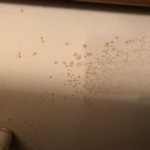How To Sand A Bathroom Cabinet: A Comprehensive Guide
Sanding a bathroom cabinet is a fundamental step in preparing it for refinishing, painting, or simply refreshing its appearance. Proper sanding removes imperfections, creates a smooth surface, and improves the adhesion of subsequent coatings. This article provides a detailed guide on how to effectively sand a bathroom cabinet, ensuring a professional-quality result.
Preparing for Sanding: Gathering Materials and Setting the Stage
Before commencing the sanding process, it is crucial to gather the necessary materials and prepare the workspace. This initial preparation ensures efficiency and safety throughout the project.
Required Materials:
* Sandpaper: A variety of grits are required, typically ranging from 120 to 220 grit for initial sanding and 220 to 320 grit for final smoothing. Specific grit selection depends on the condition of the cabinet and the desired finish. * Sanding Block or Orbital Sander: A sanding block provides manual control for detailed areas, while an orbital sander expedites the process for larger, flat surfaces. The choice depends on the cabinet's complexity and the user's preference. * Dust Mask or Respirator: Protecting the respiratory system from airborne dust particles is essential for health and safety. A dust mask is suitable for small projects, while a respirator offers more comprehensive protection for extended sanding sessions. * Safety Glasses: Eye protection is necessary to prevent dust and debris from entering the eyes, which can cause irritation or injury. * Tack Cloth: This specialized cloth is designed to remove dust particles from the surface of the cabinet, ensuring a clean surface for sanding and subsequent finishing. * Drop Cloth or Plastic Sheeting: Protecting the surrounding area from dust and debris is crucial for maintaining a clean workspace. * Screwdriver or Drill: Removing hardware like knobs, pulls, and hinges is necessary for comprehensive sanding and refinishing. * Cleaning Supplies: A mild detergent and clean cloths are used to clean the cabinet surface before sanding. * Vacuum Cleaner with Brush Attachment: A vacuum cleaner helps remove loose dust and debris from the sanding area.Workspace Preparation:
* Choose a well-ventilated area to minimize dust inhalation. If working indoors, open windows and use a fan to circulate air. * Cover the floor and surrounding surfaces with a drop cloth or plastic sheeting to protect them from dust and debris. * Ensure adequate lighting to clearly see the surface of the cabinet and identify imperfections. * Remove all hardware from the cabinet, including knobs, pulls, hinges, and any other attached components. * Clean the cabinet surface with a mild detergent and water to remove dirt, grease, and other contaminants. Allow the surface to dry completely before proceeding with sanding.The Sanding Process: Step-by-Step Instructions
The sanding process involves several stages, each contributing to the final smoothness and adhesion of the finished surface. The process should be performed systematically and with attention to detail.
Initial Sanding (120-150 Grit):
* Begin with a coarser grit sandpaper (120-150 grit) to remove existing finishes, imperfections, and rough spots. * If using a sanding block, wrap the sandpaper around the block and secure it. If using an orbital sander, attach the sandpaper to the sanding pad. * Apply light, even pressure and sand in the direction of the wood grain. Avoid applying excessive pressure, which can create uneven surfaces. * Work in small, overlapping strokes, ensuring that all areas of the cabinet are sanded evenly. * Pay particular attention to edges and corners, as these areas are prone to damage and require careful sanding. * Periodically check the sandpaper for clogging and replace it as needed. Clogged sandpaper is less effective and can scratch the surface.Intermediate Sanding (180-220 Grit):
* After the initial sanding, switch to a medium-grit sandpaper (180-220 grit) to further smooth the surface and remove any remaining imperfections. * Use the same sanding technique as in the initial sanding process, applying light, even pressure and working in the direction of the wood grain. * Focus on blending the sanded areas with the surrounding surfaces, creating a smooth and uniform finish. * Inspect the surface carefully for any remaining scratches or imperfections and sand those areas as needed.Final Sanding (220-320 Grit):
* For the final sanding stage, use a fine-grit sandpaper (220-320 grit) to create an ultra-smooth surface that is ideal for painting or staining. * Apply very light pressure and sand in the direction of the wood grain. * The goal of final sanding is to polish the surface and remove any remaining blemishes. * After final sanding, the surface should feel smooth to the touch and appear uniform in color and texture.Detail Sanding:
* For intricate details, moldings, and hard-to-reach areas, use a sanding sponge or folded sandpaper. * Sand these areas carefully, paying attention to the shape and contours of the surface. * Avoid rounding over sharp edges or damaging delicate details.Cleaning Between Sanding Stages:
* After each sanding stage, thoroughly remove dust and debris from the cabinet surface. * Use a vacuum cleaner with a brush attachment to remove loose dust particles. * Follow up with a tack cloth to remove any remaining dust residue. * A clean surface is essential for effective sanding and ensures that subsequent coatings will adhere properly.Post-Sanding Procedures: Inspection and Preparation for Finishing
After the sanding process is complete, it is crucial to inspect the cabinet thoroughly and prepare it for finishing. The proper steps taken after sanding can significantly impact the ultimate quality and durability of the finished product.
Inspection:
* Carefully inspect the entire cabinet surface for any remaining imperfections, scratches, or rough spots. * Use a bright light to highlight any areas that require further attention. * If any imperfections are found, sand those areas lightly with fine-grit sandpaper (220-320 grit) and re-clean the surface. * Ensure that all edges and corners are smooth and free of sharp edges or splinters.Final Cleaning:
* Perform a final cleaning of the cabinet surface to remove any remaining dust and debris. * Use a vacuum cleaner with a brush attachment to remove loose dust particles. * Wipe down the surface with a tack cloth to remove any remaining dust residue.Primer Application (Optional):
* Applying a primer is recommended, especially when painting or staining a previously finished cabinet. * Primer helps to seal the wood, create a uniform surface, and improve the adhesion of the topcoat. * Choose a primer that is compatible with the intended topcoat. * Apply the primer according to the manufacturer's instructions. * Allow the primer to dry completely before proceeding with the finishing process.Hardware Reinstallation:
* After the finishing process is complete, carefully re-install the hardware, including knobs, pulls, hinges, and any other attached components. * Ensure that the hardware is securely attached and properly aligned. * Replace any damaged or worn hardware as needed.By following these detailed instructions, one can effectively sand a bathroom cabinet, creating a smooth, clean surface that is ready for finishing. Proper sanding is a critical step in achieving a professional-quality result and ensuring the long-term durability of the refinished cabinet.

How To Paint Bathroom Cabinets Secrets For A Perfect Finish

How To Paint A Bathroom Vanity Ace Hardware

Step By Guide How To Paint A Bathroom Vanity Cabinet Love Grows Wild
.jpg?strip=all)
Painting A Bathroom Vanity Again Dream Green Diy

How To Paint Cabinets Last Painting A Bathroom Vanity Maison De Pax

How To Paint A Bathroom Vanity Secrets For Perfect Finish

How To Paint Laminate Cabinets Love Renovations

How To Paint Bathroom Vanity Cabinets Tutorial Benjamin Moore

How To Paint Bathroom Vanity Cabinets Tutorial Benjamin Moore

How To Paint A Bathroom Vanity Angela Marie Made
Related Posts







